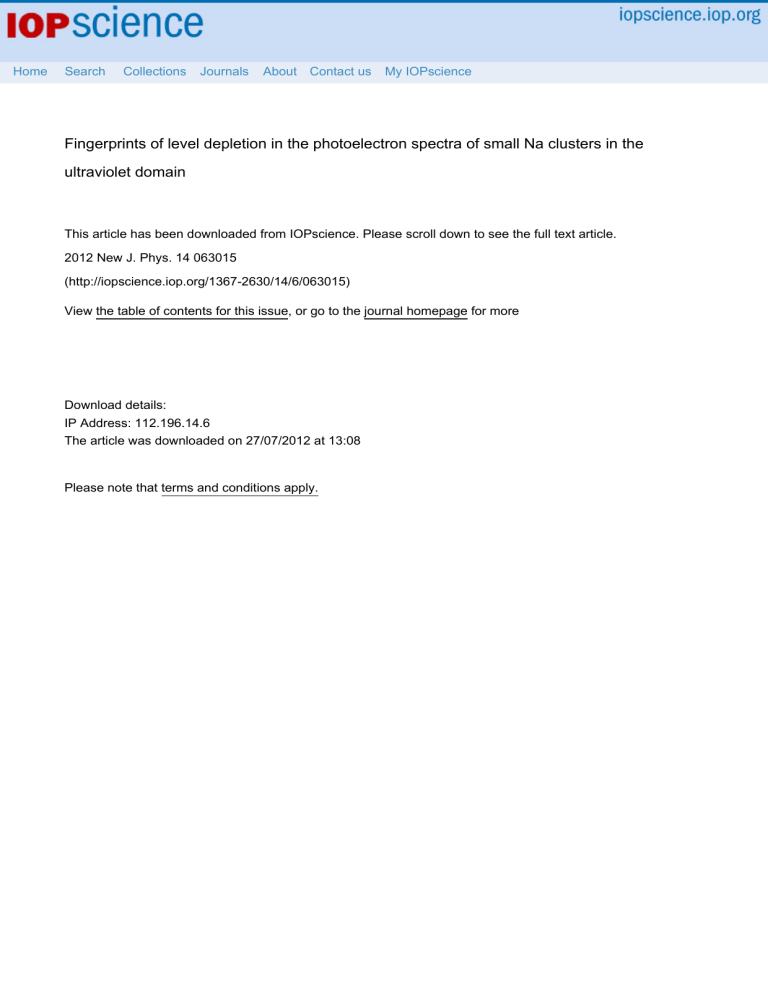Na Cluster Photoelectron Spectra: Level Depletion Study
advertisement

Home Search Collections Journals About Contact us My IOPscience Fingerprints of level depletion in the photoelectron spectra of small Na clusters in the ultraviolet domain This article has been downloaded from IOPscience. Please scroll down to see the full text article. 2012 New J. Phys. 14 063015 (http://iopscience.iop.org/1367-2630/14/6/063015) View the table of contents for this issue, or go to the journal homepage for more Download details: IP Address: 112.196.14.6 The article was downloaded on 27/07/2012 at 13:08 Please note that terms and conditions apply. New Journal of Physics The open–access journal for physics Fingerprints of level depletion in the photoelectron spectra of small Na clusters in the ultraviolet domain P M Dinh1,2 , S Vidal1,2 , P-G Reinhard3 and E Suraud1,2 1 Université de Toulouse, UPS, Laboratoire de Physique Théorique (IRSAMC), F-31062 Toulouse, France 2 CNRS, LPT (IRSAMC), F-31062 Toulouse, France 3 Institut für Theoretische Physik, Universität Erlangen, D-91058 Erlangen, Germany E-mail: dinh@irsamc.ups-tlse.fr New Journal of Physics 14 (2012) 063015 (8pp) Received 19 March 2012 Published 14 June 2012 Online at http://www.njp.org/ doi:10.1088/1367-2630/14/6/063015 Abstract. In the framework of time-dependent density functional theory (TDDFT), we study electronic emission from small Na clusters after irradiation by an intense femtosecond laser pulse. Photoelectron spectra (PES) are compared with level depletion, i.e., the electron loss at each single-electron level. Laser frequencies in the UV range (from 9 to 19 eV) are explored. We find a clear correlation of the peak areas in the photoelectron spectra with the state depletion. This thus allows experimental access to the ionization mechanism. This correlation, moreover, demonstrates that one can find a physical interpretation of the Kohn–Sham orbitals in PES, as in real-time TDDFT. Contents 1. Introduction 2. Theoretical framework 3. Discussion and results 3.1. An illustrative example . . . . . . . . . . . . . . . . . . . . . . . . . . . . . . 3.2. Systematic trends . . . . . . . . . . . . . . . . . . . . . . . . . . . . . . . . . 4. Conclusion Acknowledgments References New Journal of Physics 14 (2012) 063015 1367-2630/12/063015+08$33.00 2 2 4 4 5 6 7 7 © IOP Publishing Ltd and Deutsche Physikalische Gesellschaft 2 1. Introduction Photons provide a very convenient tool for the analysis of the structure and dynamic properties of clusters and molecules [1]. Laser irradiation of clusters and molecules leads to electronic emission, the kinematic properties of which provide key information on the emitting system [2–4]. Pulses in the femtosecond (fs) range have opened up a wide area of fs spectroscopy. This allows a detailed tracking of ionic dynamics in molecules and clusters; see, e.g., [5–8]. The availability of coherent light beyond the visible, ranging from ultraviolet (UV) up to x-rays, offers a new, interesting option for such studies. Free electron lasers (FEL) provide here a particularly versatile source [9] that can be tuned to deliver fs pulses at high frequency and simultaneously high intensity. It is thus now within the reach of experiments to study, in great detail, photoemission even from possibly deep-lying electronic states in neutral or cationic molecules and clusters. At the side of observables, photoelectron spectroscopy and angular distributions of emitted electrons [2] provide an invaluable tool for the investigation of the system’s properties. Experimental tools for such an analysis, especially photoelectron spectra (PES), have indeed been further developed recently and are increasingly being used (for an overview in cluster physics, see [10]). Electronic emission mechanisms are highly sensitive to laser frequency [4, 10]. This can even be analyzed by studying the level depletion of electronic levels [11], namely how much of the total emission stems from a given electronic state. Such an analysis is quite interesting as it reveals underlying emission mechanisms in the course of a laser irradiation. Still, as such, it remains a purely theoretical object. A natural observable for the analysis of electronic emission is provided by PES. It is thus a natural candidate to check whether level depletion can be ‘visualized’ on an experimentally accessible basis. In the regimes from perturbative up to moderate excitations, PES provide a direct mapping of the energies of occupied electronic levels [12], to the extent that these levels are actually emitting electrons. One can thus expect that the PES could also give some indication of the level of depletion of a given single-electron level. The purpose of this paper is to tackle this question. For this we use time-dependent density functional theory (TDDFT) at the level of the local density approximation (LDA). The defect of LDA with respect to the self-interaction problem leads us to augment LDA by a self-interaction correction (SIC) to describe emission properties correctly. This TDDFT scheme (coupled to classical molecular dynamics of ions) has been extensively used for the description of cluster dynamics in many regimes [10, 13]. In this paper, we shall analyze PES spectra as computed from our model in relation to depletion from occupied electronic levels. We will show that there is a strong correlation between level depletion and PES peak amplitude, which confirms the consistency of this observable in our calculations and which provides a direct experimental clue to the ionization mechanism. We consider as test cases Na clusters in the regime of vacuum ultraviolet (VUV) radiation and show that the PES provides a printout of the actual ionization mechanism, as a function of laser frequency. 2. Theoretical framework We describe the laser-induced electron dynamics by means of real-time TDDFT in the standard manner [10, 13]. We solve the (time-dependent) Kohn–Sham equations for the cluster electrons on a grid in coordinate space, using time splitting for the time propagation [14] and accelerated New Journal of Physics 14 (2012) 063015 (http://www.njp.org/) 3 gradient iterations for the stationary solution [15]. The Poisson equation is solved by a fast Fourier technique combined with separate treatment of the long-range terms [16]. In the present calculations, we use the cylindrically averaged pseudo-potential scheme (CAPS) as an approximation for the electronic wave functions [17, 18]. We have checked that a full three-dimensional (3D) treatment of the electronic wave functions leads to similar results for the chosen systems which all stay close to axial symmetry. We treat the exchange-correlation energy functional from Perdew and Wang [19] at the LDA level augmented by the technically inexpensive average-density SIC (ADSIC) [20], in order to get correct ionization potentials (IP), crucial for an appropriate dynamical description of electron emission. The quantum mechanical calculation is restricted to 3s valence electrons of Na atoms. Ionic cores are treated by classical molecular dynamics (MD) in full 3D. We employ local pseudopotentials, i.e. soft Gaussian potentials as given in [21], to describe the coupling to the Na+ cores. The elimination of core electrons through pseudo-potentials requires that the laser frequencies in the study stay safely below values that could ionize core electrons. Since the eliminated 2p state of Na lies at −28.8 eV, we use at most a laser frequency of 19.4 eV to stay on the safe side. The external laser field is described in the limit of long wavelengths. In space gauge it takes the form of an external time-dependent potential π 2 V̂las = E 0 ẑ sin(ωlas t) sin t θ(t)θ(Tpulse −t), (1) Tpulse where θ is the Heaviside function, E 0 the maximum electric field, ωlas the frequency and ẑ the laser polarization axis. The pulse profile is a smooth sin2 . The pulse duration Tpulse is 80 fs and the laser field is polarized along the symmetry axis of the cylindrical box, denoted by z in the following. The time step in our calculations is 4.8 as. The mesh size is 0.8a0 and the various sizes of the numerical box are, respectively, (radial × longitudinal) 91 × 179 for Na8 , 45 × 91 for Na+9 , 101 × 173 for Na10 , 101 × 173 for Na+11 and 91 × 173 for Na2+ 22 . We use absorbing boundary conditions [10, 13, 22], here five absorbing points, throughout this paper. They gently absorb all outgoing electron flow reaching the bounds of the grid and thus prevent artifacts from reflection back into the reaction zone. We have checked that the boxes mentioned above were large enough to avoid any non-physical spurious ionization. This absorption leads to a loss of norm of each single particle state ϕα . We thus define the time-resolved depletion of the state α by ν (α) (t) = 1 − hϕα (t)|ϕα (t)i. When multiplied by the (α) occupation number n α , one obtains the average ionization Nesc out of the state α. The sum over all states finally gives the total average ionization Nesc (= the number of escaped electrons). We have pursued the simulations up to 2 × Tpulse in order to collect all ionization, i.e. up to a point where the ν (a) (t) no longer change [13, 23]. We have also chosen the laser intensity I so low that Nesc remains small, guaranteeing that we stay in the perturbative regime and that the electronic emission scales with Nesc or equivalently with I . In practice, I is about 1011 W cm−2 at lower frequencies, and reaches at most 3 × 1012 W cm−2 for the highest frequencies. In all cases, the final ionization is of the order of 10−3 . The laser frequencies ωlas are all above the IP of the considered clusters such that we are dealing with predominantly one-photon processes throughout. Together with the state-wise ionization, we record the kinetic energy of outgoing electrons to evaluate the PES [12, 24]. We choose a ‘measuring point’ rM far away from the system and close to the absorbing boundaries. We assume negligible mean field at rM , so that we encounter free particle dynamics there and only outgoing waves will pass the point rM . Thus, we can New Journal of Physics 14 (2012) 063015 (http://www.njp.org/) 4 Na10 11 ωlas=9.5 eV, I=2x10 W/cm 12 2 ωlas=16.3 eV, I=10 W/cm 1p Photoelectron yield (a.u.) Δtlas=80 fs 2 1s 2s 1s 2s 1p 0 2 4 6 8 Ekin (eV) 10 12 14 Figure 1. Calculated PES of laser-irradiated Na10 in the linear scale, for two different laser frequencies ωlas and intensities I as indicated. Solid lines stand for the yield in the forward direction, whereas the dashed lines correspond to that in the sideward direction. decompose the wave function as radially outgoing waves Z ∞ ψ(rM , t) = dk ψ̃(k, rM )e−iωt eikrM , (2) 0 where rM = |rM | and rM is the solid angle related to the direction of rM . We then compute the PES in the direction rM as ∂ 2σ (E kin , rM ) ∝ |ψ̃(k(E kin ), rM )|2 , ∂ E∂ (3) where ψ̃(k(E kin ), rM ) is the Fourier transform (in time) of ψ(rM , t). In compliance with the cylindrical box, we consider three ‘measuring’ points, namely forward, backward and sideward (with respect to the symmetry axis). The first two points are on the z-axis and would correspond to the positions of a detector in the direction of the laser polarization. Because of the symmetry, these two measuring points basically give the same yield. The sideward ‘point’ collects the photoelectron yield over the circle perpendicular to the z-axis and centered in the cylindrical box. We have previously studied the influence of the laser frequency in the depletion of Na+9 , + Na2+ 22 and C2 H4 [11]. In this paper, we consider Na8 and Na10 in addition to Na9 , and complement the analysis of the depletion results by a comparison with the trends of PES. 3. Discussion and results 3.1. An illustrative example As an illustrative example, we first discuss the case of Na10 irradiated by a laser of low frequency (9.5 eV) and another one at high frequency (16.3 eV). Na10 exhibits four nondegenerate electronic states whose energy, respectively, lies at ε1s = −5.82 eV, ε1pz = −4.78 eV, ε1px = ε1p y = −4.46 eV and ε2s = −3.64 eV. Figure 1 presents the PES in the linear scale. Thanks to the relatively low laser intensities, they display sharp peaks corresponding to one-photon emission (on the logarithmic scale, not New Journal of Physics 14 (2012) 063015 (http://www.njp.org/) 5 shown here, one can also spot two-photon processes that are, however, suppressed by two or more orders of magnitude). One can easily read from the figure the binding energies of Na10 via the relation E kin = ε + n h̄ωlas , where n denotes the number of photons involved in the process (thus here, n = 1). By comparing the low- and the high-frequency cases, we can immediately note that, for a given state, the relative peak heights strongly depend on the laser frequency. The idea of this paper is thus to monitor each peak height as a function of xlas from the one-photon spectra (since the latter exhibit the highest yield) and to compare it with the level depletion. More relevant is the area of each peak. We have thus fitted each peak with a Gaussian and we have reported in the following the ratio between dominant peaks. In particular, the peaks corresponding to the 1px y states are always suppressed by at least two orders of magnitude, whatever the cluster and ωlas . Thus, these states will not be considered on purpose in all the results presented below. Figure 1 also shows the sideward signals as dashed lines. The information one obtains from the figure is that, indeed, the height of the sideward peak also depends on the laser frequency but a comparison with the other states is impossible as such, since this yield is actually very much dominated by emission from the 1pz state only. This has thus motivated us to only discuss in the following the forward (and backward) emission. A more detailed study would require full angular distributions of the photoelectrons (or photoangular distributions (PAD)). In our group we have developed sensitive and efficient techniques to compute PAD within a full 3D treatment of the electronic wave functions [25, 26]. These calculations are, however, very expensive. For the exploration study presented in this paper, we chose to use CAPS to be able to perform an exhaustive scan of PES and level depletion as a function of laser frequency. 3.2. Systematic trends We first present in detail the case of Na+9 . The 1s state has a binding energy of −8.61 eV, whereas the 1pz and the 2-degenerate 1px,y are very close in energy (−7.40 and −7.24 eV, respectively). In the left panel of figure 2, the level depletion ν1s and ν1pz are compared with the ratio of the 1s peak area over that of the 1pz , for laser frequencies ranging from 9.5 to 19 eV. Both ratios increase monotonically and come very close together over several frequencies. While the ratio of depletion increases almost linearly with ωlas , the ratio of PES peaks shows higher than linear components. The PES signal, taken at one reference point, combines the trends overall yield with changes in the angular distribution. Anyway, we see here a very clear indication that the PES signal corresponding to a given single-electron level does reflect the level of depletion. To demonstrate that this is a general feature, we show in the right panel of figure 2 the same for the neutral cluster Na8 . The situation is basically the same. We now turn to Na10 . We recall that there are four non-degenerate states with energies ε1s = −5.82 eV, ε1pz = −4.78 eV, ε1px,y = −4.46 eV and ε2s = −3.64 eV. We found that the 1s peak area or depletion is always higher than that of the 2s state, whatever be the laser frequency. The ratios between s states are thus not presented. Figure 3 compares each s state independently with the 1pz one. The patterns are at first glance very similar to those observed in Na+9 and Na8 . However, the results from PES deviate from a monotonic trend at the low- and high-frequency edges. This is due to changes in the angular distributions which change the weight of the forward direction (measured in these PES). The cluster Na10 has a strong deformation, which leads to stronger changes in the angular distribution. New Journal of Physics 14 (2012) 063015 (http://www.njp.org/) 6 100 Na9+, 1s over 1pz Na8, 1s over 1pz depletions PES peaks depletions PES peaks 10 10 1 1 0.1 9 10 11 12 13 14 ωlas (eV) 15 16 17 18 9 10 11 12 13 14 ωlas (eV) 15 16 17 18 Figure 2. The ratio of 1s over 1pz depletion (thick curve) and that of PES peak areas (thin line) in Na+9 (left) and Na8 (right), as functions of laser frequency ωlas . Na10 100 1s / 1pz 2s / 1pz 10 1 0.1 0.01 9 10 11 12 13 14 ωlas (eV) 15 16 17 18 Figure 3. Ratios of depletions (thick curves) and that of PES peak areas (thin curves) in Na10 , as functions of laser frequency ωlas . Full lines: 1s over 1pz ; dashed lines: 2s over 1pz . All the cases discussed above show one interesting feature concerning the frequency where the ratio curves are equal to 1 (see crossing with the dotted horizontal line in figures 2 and 3). This frequency differs, of course, from case to case. But, the crossing frequencies for ratios from depletion and for ratios from PES nearly coincide for all cases. This is most probably not an accident. The reason for such coincidences is not yet clear and has to be worked out in future investigations. 4. Conclusion We have studied in this work the response of simple metal clusters to laser irradiation in terms of PES. We have compared the behavior of the PES to single-electron level depletion for processes New Journal of Physics 14 (2012) 063015 (http://www.njp.org/) 7 in the one-photon regime and found that both are strongly correlated. While level depletion is a purely theoretical observable, PES can both be computed and measured. The correlation we observe thus provides an experimental signal to analyze how single-electron levels are depleted in the course of a laser irradiation. It turns out that level depletions, and correspondingly the amplitude of PES peaks, do depend on the laser frequency. While low-frequency lasers favor emission from least bound levels, higher frequencies also significantly ionize more deeply bound states. This effect, clearly visible from the computation of depletion, can now be traced back to the PES signal. This proves once more the relevance of PES computations in relation to the analysis of detailed ionization mechanisms in the laser irradiation of molecules and clusters. Acknowledgments This work was granted access to the HPC resources of IDRIS under the allocation 2011-095115 made by GENCI (Grand Équipement National de Calcul Intensif) and the HPC resources of CALMIP (Calcul en Midi-Pyrńées) under the allocation 2011-P0522. We acknowledge support from the Institut Universitaire de France and the Humboldt Foundation during the realization of this work. References [1] Kreibig U and Vollmer M 1993 Optical Properties of Metal Clusters (Springer Series in Materials Science vol 25) (Berlin: Springer) [2] Berkowitz J 1979 Photoabsorption, Photoionization and Photoelectron Spectroscopy (New York: Academic) [3] Gosh P 1983 Introduction to Photoelectron Spectroscopy (New York: Wiley) [4] Fennel Th, Meiwes-Broer K-H, Tiggesbäumker J, Dinh P M, Reinhard P-G and Suraud E 2010 Electromagnetic signals for analyzing nonlinear cluster dynamics Rev. Mod. Phys. 82 1793 (arXiv:0904.2706) [5] Zewail A H 2000 Femtochemistry: Atomic-scale dynamics of the chemical bond J. Phys. Chem. A 104 5660–94 [6] Posthumus J H 2004 The dynamics of small molecules in intense laser fields Rep. Prog. Phys. 67 623 [7] Carley R E, Heesel E and Fielding H 2005 Femtosecond lasers in gas phase chemistry Chem. Soc. Rev. 34 949–69 [8] Hertel I V and Radloff W 2006 Ultrafast dynamics in isolated molecules and molecular clusters Rep. Prog. Phys. 69 1897 [9] Brau C 1990 Free-Electron Lasers (New York: Academic) [10] Reinhard P-G and Suraud E 2003 Introduction to Cluster Dynamics (New York: Wiley) [11] Vidal S, Wang Z P, Dinh P M, Reinhard P-G and Suraud E 2010 Frequency dependence of level depletion in Na clusters and in C2 H4 J. Phys. B: At. Mol. Opt. Phys. 43 165102 [12] Pohl A, Reinhard P-G and Suraud E 2000 Towards single particle spectroscopy of small metal clusters Phys. Rev. Lett. 84 5090 [13] Calvayrac F, Reinhard P-G, Suraud E and Ullrich C A 2000 Nonlinear electron dynamics in metal clusters Phys. Rep. 337 493 [14] Feit M D, Fleck J A and Steiger A 1982 J. Comput. Phys. 47 412 [15] Blum V, Lauritsch G, Maruhn J A and Reinhard P-G 1992 Comparison of coordinate-space techniques in nuclear mean-field calculations J. Comput. Phys. 100 364 [16] Lauritsch G and Reinhard P-G 1994 An FFT solver for the Coulomb problem Int. J. Mod. Phys. C 5 65 [17] Montag B and Reinhard P-G 1994 Phys. Lett. A 193 380 [18] Montag B and Reinhard P-G 1995 Z. Phys. D 33 265 [19] Perdew J P and Wang Y 1992 Phys. Rev. B 45 13244 New Journal of Physics 14 (2012) 063015 (http://www.njp.org/) 8 [20] Legrand C, Suraud E and Reinhard P-G 2002 Comparison of self-interaction-corrections for metal clusters J. Phys. B: At. Mol. Opt. Phys. 35 1115 [21] Kümmel S, Brack M and Reinhard P-G 1999 Ionic geometries and electronic excitations of Na+9 and Na+55 Eur. Phys. J. D 9 149 [22] Reinhard P-G, Stevenson P D, Almehed D, Maruhn J A and Strayer M R 2006 Role of boundary conditions in dynamic studies of nuclear giant resonances Phys. Rev. E 73 036709 [23] Reinhard P-G, Calvayrac F, Kohl C, Kümmel S, Suraud E, Ullrich C A and Brack M 1999 Frequencies, times, and forces in the dynamics of na clusters Eur. Phys. J. D 9 111 [24] Pohl A, Reinhard P-G and Suraud E 2001 Influence of intermediate states on photoelectron spectra J. Phys. B: At. Mol. Opt. Phys. 34 4969 [25] Wopperer P, Faber B, Dinh P M, Reinhard P-G and Suraud E 2010 Orientation averaged angular distributions of photo-electrons from free Na clusters Phys. Lett. A 375 39 [26] Wopperer P, Faber B, Dinh P M, Reinhard P-G and Suraud E 2010 Angular distributions of photoelectrons from free Na clusters Phys. Rev. A 82 063416 New Journal of Physics 14 (2012) 063015 (http://www.njp.org/) Copyright of New Journal of Physics is the property of IOP Publishing and its content may not be copied or emailed to multiple sites or posted to a listserv without the copyright holder's express written permission. However, users may print, download, or email articles for individual use.



